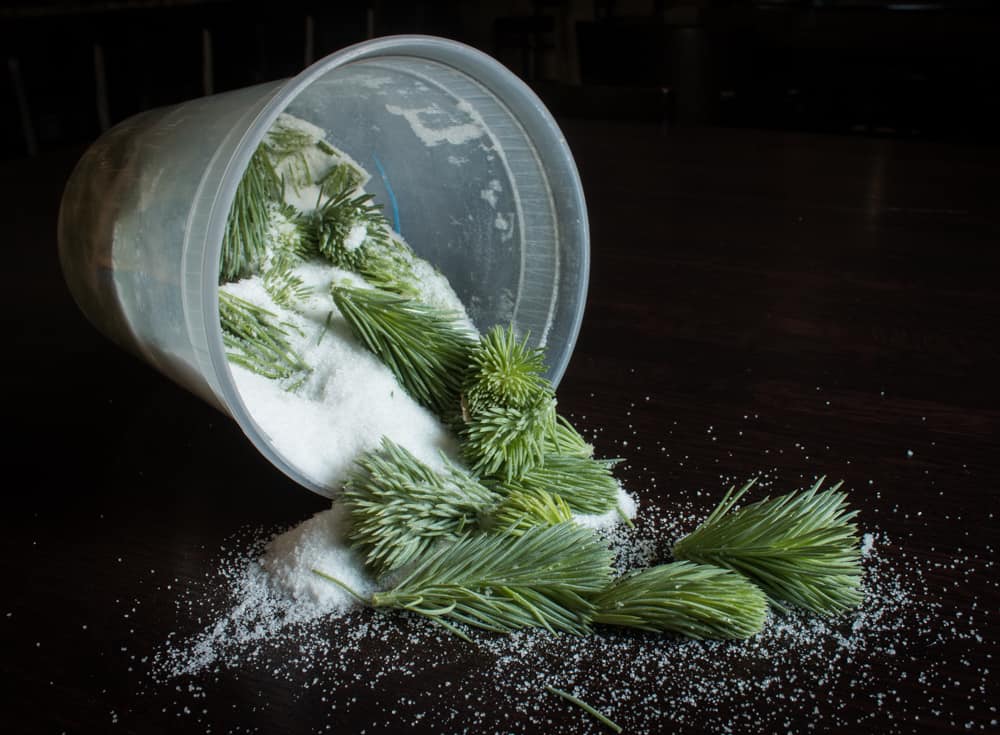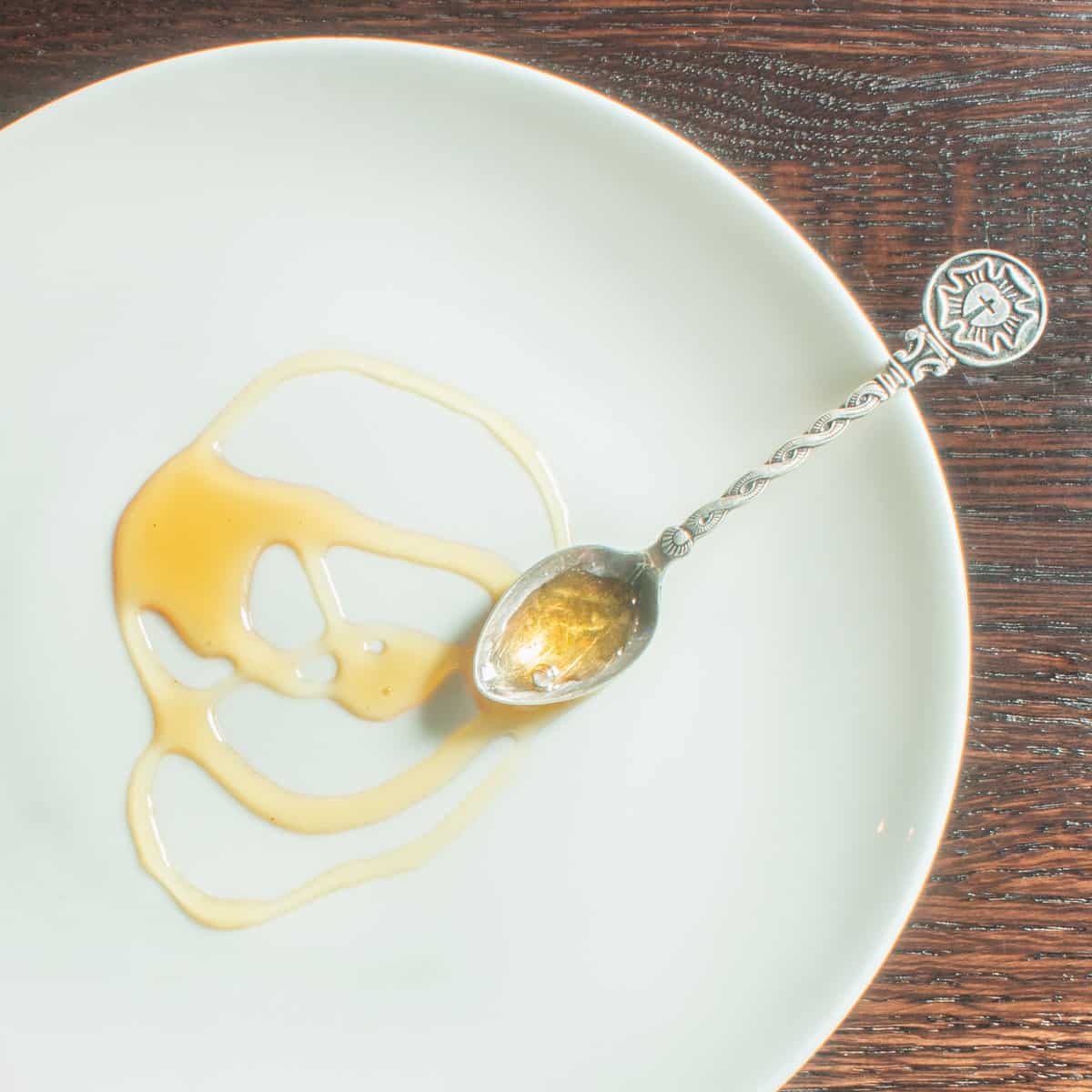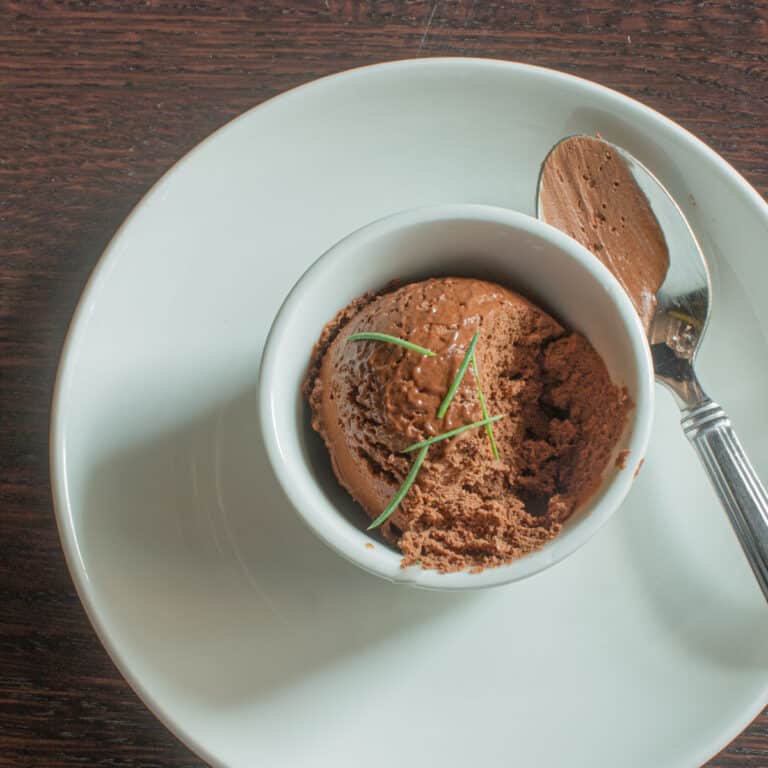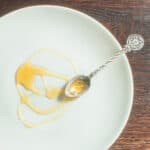Update:
This is a shortcut I used to have my bartenders make when I was first cooking with spruce tips. It's done quickly, but it's not as good as the real deal, which takes at least a month, for that, see my post on classic spruce tip syrup.

Original post
Spruce (and cedar) have tons of untapped possibilities. A green ice cream we make from young spruce tips never ceases to get oohs and ahs at the restaurant and I remember one guest I brought a scoop of it to ran back to the kitchen looking for me and asked my staff where "god" had gone, which was a bit awkward.
This past year, I ended up picking way more spruce tips than I could go through all at once, even with the relatively long shelf life they have under refrigeration (they'll be good for about a month) I knew I needed to do something with them.
Making a syrup out of spruce tips ensures I have enough spruce flavor to last into the summer, if not longer. Spruce tip recipes like syrup aren't a secret though-bartenders make drinks from it and people are using it for all sorts of things.
Basic spruce simple syrup is, ok, but there's a way to transform it into something very special, a concentrate with a deeper flavor than the original.

The idea came after a conversation I had with my friend Dan, a friend of mine and a local hunter of things. He told me about a syrup Italians make from the buds of Mugo pine, called mugolio. It's available online, but the price is ridiculous. Most vendors want to charge 10$ an ounce for the stuff, which is crazy when you consider how easy it is to make something similar yourself.
For the traditional syrup, you take some spruce tips and toss them with equal parts sugar, then pack them in a jar and put them in a sunny place for a couple months. The sugar gradually extracts water from the spruce and creates a syrup, which can be strained and used to flavor drinks, desserts, or what have you.
I've done a bunch of experimenting with this, and there's a couple ways of going about it. The easiest way is to just drain off the natural syrup and use as is. But that takes a long time, and I can be impatient. Needless to say, you can make a good version cooking spruce tips with simple syrup without aging in a sunny place, although aging something in a sunny place is more romantic.
The real secret is in the final process. After you extract the syrup, you cook it down slowly until the color changes to amber, which deepens the flavor. It's really fool-proof too, since if you cook the syrup down too far and it crystallizes or gets too thick, you can just loosen it with a little cool water to return it to the consistency you want, as long as it hasn't scorched.
You can use the spruce syrup like honey or maple, but how does it work with other things? I've come up with a couple different ideas, but my favorite happened when I noticed a large, unused block of bitter, unsweetened chocolate at the restaurant.
Since the spruce syrup is sweet, you need to add it in place of sugar in a dessert. Chocolate-spruce mousse turned out really good, just make sure to use unsweetened chocolate. See that recipe here.

Caramelized Spruce Syrup
Equipment
- 1 3 quart sauce pot
Ingredients
- 4 packed cups fresh or frozen spruce tips
- 2 cups sugar
- 2 cups water
Instructions
- Grind the spruce tips and sugar in a food processor, then mix with the water, bring to a rolling boil, turn off the heat and allow to sit overnight. The next day, strain the syrup, then return it to the pan, cooking until it takes on a light amber color and the consistency resembles warm honey.
- Transfer the syrup to labeled, dated container and refrigerate until needed. If the syrup becomes very thick when it's cold, thin it with a bit of cold water until it reaches your desired consistency.


Andras Ocskai
Hi, thanks for the recepies.
A few questions in my mind:
1: If I make the "shortcut" syrup, can I still re use the "discarded" parts?
"The next day, strain the syrup, then return it to the pan" but the filtered out parts still have potential, right? SO If I jar them and ferment them with added suger it will release more?
2: yes it is SPRUCE TIP syrup, but can I use different pines, cedar, tuya tips too?
3: only tips? Can I use soft fresh branches from spruce (or any pine /tuya type tree) Maybe need more fermentation, or if the branches harder and thicker have to cook it longer? Maybe more resin in the branches and can be poisonous?
4: About the pine cone syrup: I know the best is the young cones. But what is I use the really hard winter cones or those what have the seeds ready to go? Is it taste horrible, or just less water in it? Or is it poisonous at any stage?
5: can I put fresh (or dried) thyme in it to make it more flavourful?
Thank you for your answers in advance
Alan Bergo
Hi Andras, brief answers here.
1. Don't bother.
2. Yes.
3. If they're pureed in a highspeed blender, yes, but it's not the same.
4. It will taste like nothing.
5. Thyme is unnecessary.
Andras
Thank you very much for quick reply!
We collected 9kg yesterday
3/4 type of cones and young branches.
Now I need to find suitable buckets.
I hope plastic buckets would be fine. Maybe I can get some empty mayonnaise buckets from a nearby fish& chips shop.
Can confirm plastic buckets with lids would be fine for the maceration process?
Thank you
Alan Bergo
That should work. I prefer restaurant polycarbonate containers as opposed to run of the mill plastic as they're food safe.
SJ
How long does this last for? And what’s the best way to store it? Does the type of sugar matter?
Alan Bergo
Sugar type doesn't matter. It will last for months in the fridge and can be canned as for maple syrup.
4waystoyummy
My mother from Austria taught me how to make the "romantic" version where the sun pulls the goodness from the fir tips. I find I get very little syrup most years and have attributed that to the fact that here in the NW we do not have hard winters. Like the tapping of maples...don't they need cold to store the sugars? I will try to add water which is new to me. I love the taste and we were given it as a health tonic. Thank you!
Alan Bergo
Yes this is a short cut recipe--it won't give as strong an infusion as the sun syrup, but it's pretty good for only 24 hours.
4waystoyummy
I'm sure it's delicious and I'll try it. I just found a pickle recipe with the tips, a Scandinavian recipe I think. Eager to try it! I have Sweet Woodruff syrup in the works right now. Life is fun and tasty! Thanks!
Melissa Hoffman
Thank you so much for sharing all this. We have fresh tips growing right now on our farm, and as a self-taught chef, I appreciate that you share your process of learning so we can all benefit. Gratitude!
Barbara
When you pack it in a jar to put in the sun, is "equal parts" by weight or by volume?
Alan Bergo
Thanks for that, it is equal parts by volume. For example, 1 measured cup of spruce tips to 1 cup white sugar. You could definitely try experimenting with a weight version though.
Liz Terrance
I see all these incredible recipes with spruce and pine and they make me so jealous! I'm allergic to conifers 🙁
Do you have anything to recommend with a similar flavor profile?
Kristin
When do
You collect spruce tips? Thanks
Alan Bergo
They have a short season in the Spring. Make sure not to overharvest from a tree or pick directly from the top of the tree since it will stunt it's growth.
Laura
You mention using cedar as well as spruce tips. I have recently moved to Central TX & there are a lot of cedar (actually ash juniper). Can I use the greenery from the cedar to make the syrup?
Alan Bergo
You can go ahead and try, I haven't written a recipe for using the mature needles yet, but here's the jist: finely chop up cedar and combine with 2 parts water and 1 part sugar. Simmer the mixture then allow to sit and infuse for a couple days, then strain and reduce slowly until it caramelizes and browns lightly. If the mixture crystalizes, just add some water, heat and dilute until it becomes liquid again.